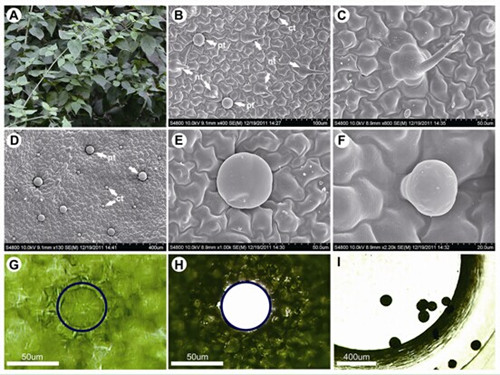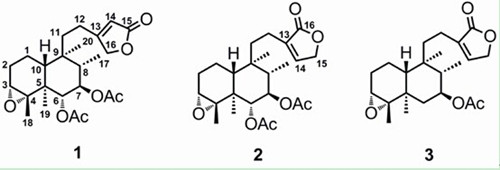藤状火把花盾状腺毛中具有防御病虫害功能的次生代谢产物

图1:藤状火把花及其盾状腺毛的激光显微切割收集分析

图2:藤状火把花盾状腺毛中的新颖防御功能克罗烷二萜Seguiniilactones A-C (1-3)
腺毛是植物在长期进化过程中为了应对生物和非生物环境胁迫而演化出来的特殊结构,其广泛分布于陆地植物地上部分的表面。植物腺毛是合成和贮存各种类型次生代谢产物的重要场所(被誉为“细胞工厂”),这些特殊的化学物质往往具有独特的化学结构和广泛的生物功能,在植物防御生物和非生物胁迫中起着重要作用。然而由于腺毛结构微小,难以准确收集。迄今为止,绝大多数植物腺毛中的次生代谢产物及其生物功能都还属于未知。
中国科学院昆明植物研究所黎胜红研究组多年来致力于植物腺毛的次生代谢产物及其生物功能研究,建立了激光显微切割-超低温核磁共振-超高压液相色谱/质谱联用(LMD-cryoNMR-UPLC/MS/MS)的超微量和高精确度单细胞水平植物化学研究新技术和方法。此前,该课题组已从唇形科(Lamiaceae)植物米团花(Leucosceptrum canum)和火把花(Colquhounia coccinea var. mollis)的腺毛中发现了两类具有防御功能的新奇骨架(分别命名为米团花烷和火把花烷)二倍半萜(Angew. Chem. Int. Ed. 2010, 49: 4471-4475;Org. Lett. 2013, 15: 1694-1697)。
最近,该课题组采用LMD-UPLC/MS/MS方法从另一唇形科植物藤状火把花(Colquhounia seguinii)的盾状腺毛中发现了3个新的克罗烷二萜Seguiniilactones A-C。生物活性测试发现所有化合物对甜菜夜蛾(Spodoptera exigua)均表现出很强的拒食活性,其中Seguiniilactone A比商业化的印楝油的拒食活性高17倍。构效关系分析表明,α-取代α,β-不饱和γ-内酯为该类化合物具有强拒食活性的重要官能团。定量分析发现,该类化合物在盾状腺毛和叶片中的含量与它们的拒食中浓度相当或更高,足以阻止昆虫对该植物叶片的取食。此外,Seguiniilactone C还对该植物病叶中分离得到的6株优势真菌显示中等的抗真菌活性,表明克罗烷二萜化合物在该植物中具有重要的防御病虫害功能。
该研究结果发表于Journal of Integrative Plant biology上,李春环博士和刘燕博士为该论文并列第一作者。研究得到NSFC-云南联合基金重点项目(U1202263)、“973”课题(2013CB127505)、国家自然基金委项目(31070320,31470395,31100222)和中国科学院“百人计划”人才项目的资助。
原文摘要:
Peltate glandular trichomes of Colquhounia seguinii harbor new defensive clerodane diterpenoids
Chun-Huan Li, Yan Liu, Juan Hua, Shi-Hong Luo andSheng-Hong Li
Glandular trichomes produce a wide variety of secondary metabolites that are considered as major defensive chemicals against herbivore attack. The morphology and secondary metabolites of the peltate glandular trichomes of a lianoid Labiatae, Colquhounia seguinii Vaniot, were investigated. Three new clerodane diterpenoids, seguiniilactones A-C (1–3), were identified through precise trichome collection with laser microdissection, metabolic analysis with ultra performance liquid chromatography-tandem mass spectrometer, target compound isolation with classical phytochemical techniques, structure elucidation with spectroscopic methods. All compounds showed significant antifeedant activity against a generalist plant-feeding insect Spodoptera exigua. Seguiniilactone A (1) was approximately 17-fold more potent than the commercial neem oil. α-Substituted α,β-unsaturated γ-lactone functionality was found to be crucial for strong antifeedant activity of this class of compounds. Quantitative results indicated that the levels of these compounds in the peltate glandular trichomes and leaves were sufficiently high to deter the feeding by generalist insects. Moderate antifungal activity was observed for seguiniilactone C (3) against six predominant fungal species isolated from the diseased leaves of C. seguinii, while seguiniilactones A and B were generally inactive. These findings suggested that seguiniilactones A–C might be specialized secondary metabolites in peltate glandular trichomes for the plant defense against insect herbivores and pathogens.
作者:中科院

